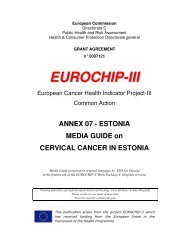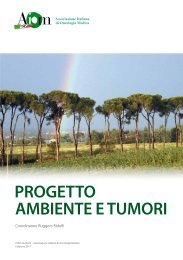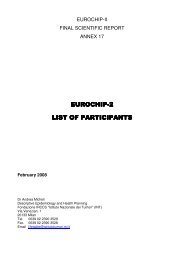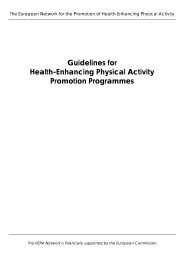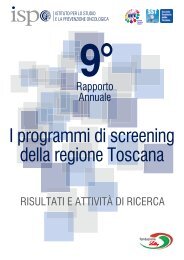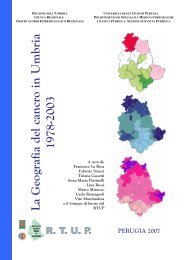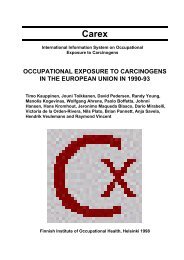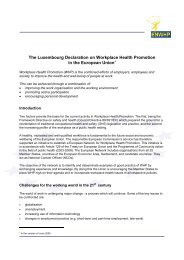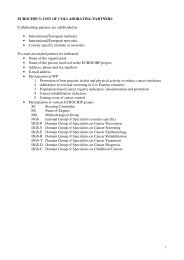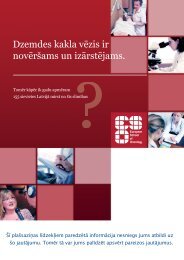EUROCHIP-3 WP7 DISCUSSION ON ALL FOCUS LIST (A) non-HR ...
EUROCHIP-3 WP7 DISCUSSION ON ALL FOCUS LIST (A) non-HR ...
EUROCHIP-3 WP7 DISCUSSION ON ALL FOCUS LIST (A) non-HR ...
Create successful ePaper yourself
Turn your PDF publications into a flip-book with our unique Google optimized e-Paper software.
<strong>EUROCHIP</strong>-3 <strong>WP7</strong> <strong>DISCUSSI<strong>ON</strong></strong> <strong>ON</strong> <strong>ALL</strong> <strong>FOCUS</strong> <strong>LIST</strong>(A) <strong>non</strong>-<strong>HR</strong>/(B) <strong>non</strong>-B mature 15.02.2011MINIMUM REQUIREMENT TOOLS- DIAGNOSTICS1.Di.04by who and whenMRD (minimal residual disease) in cytofluorimetrySpecialistLaboratory-biologist-evidencediscussion to evidenceproblemsHTA referencedone to identify residual diseaseNumerous studies suggesting differential outcome by MRD1-2 levelRequirement or diagnosis can be made by morphology. Required for stratification of therapyCentralization of samples in few laboratoriesStandardisation of technologyConclusions THIS WILL BE FINALISED DURING THE NEXT <strong>WP7</strong> MEETING in JUNE 2011Alternatives do not exist - should be considered -may exist pending further researchAlternativeby who and whenevidencediscussion to evidenceproblemsHTA referenceIf applicableConclusions THIS WILL BE FINALISED DURING THE NEXT <strong>WP7</strong> MEETING in JUNE 2011Alternatives do not exist - should be considered -may exist pending further research1
<strong>EUROCHIP</strong>-3 <strong>WP7</strong> <strong>DISCUSSI<strong>ON</strong></strong> <strong>ON</strong> <strong>ALL</strong> <strong>FOCUS</strong> <strong>LIST</strong>(A) <strong>non</strong>-<strong>HR</strong>/(B) <strong>non</strong>-B mature 15.02.2011ADDITI<strong>ON</strong>AL TOOLS –Diagnostics1.Di.07by who and whenevidenceBrain MRI/CTRadiologistDone to assess brain toxicity or damagesBasic test level 1 evidence base literaturediscussion to evidenceproblemsHTA referenceTo detect possible CNS involvement - Not standard test for diseaseEthical concerns for CT; High MRI costConclusions THIS WILL BE FINALISED DURING THE NEXT <strong>WP7</strong> MEETING in JUNE 2011Alternatives do not exist - should be considered -may exist pending further researchAlternativeby who and whenevidencediscussion to evidenceproblemsHTA referenceIf applicableConclusions THIS WILL BE FINALISED DURING THE NEXT <strong>WP7</strong> MEETING in JUNE 2011Alternatives do not exist - should be considered -may exist pending further research2
<strong>EUROCHIP</strong>-3 <strong>WP7</strong> <strong>DISCUSSI<strong>ON</strong></strong> <strong>ON</strong> <strong>ALL</strong> <strong>FOCUS</strong> <strong>LIST</strong>(A) <strong>non</strong>-<strong>HR</strong>/(B) <strong>non</strong>-B mature 15.02.2011ADDITI<strong>ON</strong>AL TOOLS –Diagnostics1.Di.09by who and whenevidencediscussion to evidenceproblemsHTA referencePCR-MRDSpecialist-Laboratory- biologistDone to detect molecular involvement or remissionNumerous studies suggesting differential by MRD 1 level• Flohr T, Schrauder A, Cazzaniga G et al. Minimal residual disease-directed riskstratification using real-time quantitative PCR analysis of immunoglobulin and T-cellreceptor gene rearrangements in the international multicenter trial AIEOP-BFM <strong>ALL</strong> 2000for childhood acute lymphoblastic leukemia. Leukemia 2008;22(4):771-82.• van der Velden VH, Hochhaus A, Cazzaniga G, et al. Detection of minimal residualdisease in hematologic malignancies by real-time quantitative PCR: principles,approaches, and laboratory aspects. Leukemia. 2003;17:1013-1034.• van Dongen JJ, Langerak AW, Bruggemann M, et al. Design and standardization of PCRprimers and protocols for detection of clonal immunoglobulin and T-cell receptor generecombinations in suspect lymphoproliferations: report of the BIOMED-2 ConcertedAction BMH4-CT98-3936. Leukemia. 2003;17:2257-2317.• Dworzak MN, Froschl G, Printz D, et al. Prognostic significance and modalities of flowcytometric minimal residual disease detection in childhood acute lymphoblastic leukemia.Blood. 2002;99:1952-1958.• Gaipa G, Basso G, Maglia O, et al. Drug-induced immunophenotypic modulation inchildhood <strong>ALL</strong>: implications for minimal residual disease detection. Leukemia.2005;19:49-56.• Ratei R, Karawajew L, Lacombe F, et al. Discriminant function analysis as decisionsupport system for the diagnosis of acute leukemia with a minimal four color screeningpanel and multiparameter flow cytometry immunophenotyping. Leukemia.2007;21:1204-1211.• Veltroni M, De Zen L, Sanzari MC, et al. Expression of CD58 in normal, regenerating andleukemic bone marrow B cells: implications for the detection of minimal residual diseasein acute lymphocytic leukemia. Haematologica. 2003;88:1245-1252.• Basso G, Veltroni M, Valsecchi MG, et al. Risk of relapse of childhood acutelymphoblastic leukemia is predicted by flow cytometric measurement of residual diseaseon day 15 bone marrow. J Clin Oncol. 2009 Nov 1;27(31):5168-74Required for stratification of therapy and to be sure of CR but not an absolute requirementfor diagnosis (Diagnosis can be made by morphology and immuno-cytochemistry)Standardisation of technology and methodology is required (not always available)Studies not availableConclusions THIS WILL BE FINALISED DURING THE NEXT <strong>WP7</strong> MEETING in JUNE 2011Alternatives do not exist - should be considered -may exist pending further researchalternativeby who and whenevidencediscussion to evidenceproblemsHTA referenceTopic to be further investigatedConclusions this will be finalised during the next wp7 meeting in june 2011Alternatives do not exist - should be considered -may exist pending further research3
<strong>EUROCHIP</strong>-3 <strong>WP7</strong> <strong>DISCUSSI<strong>ON</strong></strong> <strong>ON</strong> <strong>ALL</strong> <strong>FOCUS</strong> <strong>LIST</strong>(A) <strong>non</strong>-<strong>HR</strong>/(B) <strong>non</strong>-B mature 15.02.2011MINIMUM REQUIREMENT TOOLS- Radiotherapy4.Ra.01by who and whenRadiotherapy only on specific demand (only <strong>HR</strong> or CNS+)(only <strong>HR</strong> or CNS+)evidence • Schrappe M, Reiter A, Ludwig WD, et al. Improved outcome in childhood acutelymphoblastic leukemia despite reduced use of anthracyclines and cranialradiotherapy: results of trial <strong>ALL</strong>-BFM 90. German-Austrian-Swiss <strong>ALL</strong>-BFM StudyGroup. Blood. 2000;95:3310-3322.• Conter V, Schrappe M, Arico M, et al. Role of cranial radiotherapy for childhood T-cellacute lymphoblastic leukemia with high WBC count and good response to prednisone.Associazione Italiana Ematologia Oncologia Pediatrica and the Berlin-Frankfurt-Munster groups. J Clin Oncol. 1997;15:2786-2791.• Conter V, Arico M, Valsecchi MG, et al. Intensive BFM chemotherapy for childhood<strong>ALL</strong>: interim analysis of the AIEOP-<strong>ALL</strong> 91 study. Associazione Italiana EmatologiaOncologia Pediatrica. Haematologica. 1998;83:791-799.• Schrappe M, Reiter A, Henze G, et al. Prevention of CNS recurrence in childhood <strong>ALL</strong>:results with reduced radiotherapy combined with CNS-directed chemotherapy in fourconsecutive <strong>ALL</strong>-BFM trials. Klin Padiatr. 1998;210:192-199.discussion to evidenceproblemsHTA referenceAccess limited due to organizational aspects and linked to network activity limitationsConclusions THIS WILL BE FINALISED DURING THE NEXT <strong>WP7</strong> MEETING in JUNE 2011Alternatives do not exist - should be considered -may exist pending further researchalternativeby who and whenevidencediscussion to evidenceproblemsHTA referenceStructural EU funds should be allocated to network-affiliated institutesConclusions THIS WILL BE FINALISED DURING THE NEXT <strong>WP7</strong> MEETING in JUNE 2011Alternatives do not exist - should be considered -may exist pending further research4
<strong>EUROCHIP</strong>-3 <strong>WP7</strong> <strong>DISCUSSI<strong>ON</strong></strong> <strong>ON</strong> <strong>ALL</strong> <strong>FOCUS</strong> <strong>LIST</strong>(A) <strong>non</strong>-<strong>HR</strong>/(B) <strong>non</strong>-B mature 15.02.2011ADDITI<strong>ON</strong>AL TOOLS – Medical Oncology5.On.14by who and whenevidencediscussion to evidenceproblemsHTA referencePeg - Asparaginasetherapy tooladministered by physician in a multidrug regimen specific for <strong>ALL</strong> cellsCost-effectiveness studies to be considered in relation to alternatives (see below)Conclusions THIS WILL BE FINALISED DURING THE NEXT <strong>WP7</strong> MEETING in JUNE 2011Alternatives may exist and further investigation is requiredalternativesby who and whenevidenceL-Asparaginase L-Asi E.Coli, Erwinasemultidrug regimen specific for <strong>ALL</strong> cellskey in standard therapy - randomised evidence that optimal exposure improves outcome2 level references• Abuchowski A, Kazo GM, Verhoest CR, Jr., et al. Cancer therapy with chemically modifiedenzymes. I. Antitumor properties of polyethylene glycol-asparaginase conjugates. CancerBiochem Biophys. 1984;7:175-186.• Asselin BL, Whitin JC, Coppola DJ, Rupp IP, Sallan SE, Cohen HJ. Comparativepharmacokinetic studies of three asparaginase preparations. J Clin Oncol. 1993;11:1780-1786.• Muller HJ, Loning L, Horn A, et al. Pegylated asparaginase (Oncaspar) in children with<strong>ALL</strong>: drug monitoring in reinduction according to the <strong>ALL</strong>/NHL-BFM 95 protocols. Br JHaematol. 2000;110:379-384.• Park YK, Abuchowski A, Davis S, Davis F. Pharmacology of Escherichia Coli-Lasparaginasepolyethylene glycol adduct. Anticancer Res. 1981;1:373-376.• Avramis VI, Sencer S, Periclou AP et al. A randomized comparison of native Escherichiacoli asparaginase and polyethylene glycol conjugated asparaginase for treatment ofchildren with newly diagnosed standard-risk acute lymphoblastic leukemia: a Children'sCancer Group study. Blood 2002 Mar 15;99(6):1986-94. Erratum in: Blood 2002 Sep1;100(5):1531.• Rizzari C, Citterio M, Zucchetti M et al. A pharmacological study on pegylatedasparaginase used in front-line treatment of children with acute lymphoblastic leukemia.Haematologica. 2006 Jan;91(1):24-31.• Jarrar M, Gay<strong>non</strong> PS, Periclou AP et al. Asparagine depletion after pegylated E. coliasparaginase treatment and induction outcome in children with acute lymphoblasticleukemia in first bone marrow relapse: a Children's Oncology Group study (CCG-1941).Pediatr Blood Cancer. 2006 Aug;47(2):141-6.• Wetzler M, Sanford BL, Kurtzberg J et al. Effective asparagine depletion with pegylatedasparaginase results in improved outcomes in adult acute lymphoblastic leukemia:Cancer and Leukemia Group B Study 9511. Blood 2007 May 15;109(10):4164-7.• Abshire TC, Pollock BH, Billett AL et al. Weekly polyethylene glycol conjugated L-asparaginase compared with biweekly dosing produces superior induction remissionrates in childhood relapsed acute lymphoblastic leukemia: a Pediatric Oncology GroupStudy. Blood 2000 Sep 1;96(5):1709-15.• Sallan SE, Hitchcock-Bryan S, Gelber R, Cassady JR, Frei E, 3rd, Nathan DG. Influence ofintensive asparaginase in the treatment of childhood <strong>non</strong>-T-cell acute lymphoblasticleukemia. Cancer Res. 1983;43:5601-5607.• Silverman LB, Gelber RD, Dalton VK, et al. Improved outcome for children with acutelymphoblastic leukemia: results of Dana-Farber Consortium Protocol 91-01. Blood.5
<strong>EUROCHIP</strong>-3 <strong>WP7</strong> <strong>DISCUSSI<strong>ON</strong></strong> <strong>ON</strong> <strong>ALL</strong> <strong>FOCUS</strong> <strong>LIST</strong>(A) <strong>non</strong>-<strong>HR</strong>/(B) <strong>non</strong>-B mature 15.02.2011discussion to evidenceproblemsHTA reference2001;97:1211-1218.• Killander D, Dohlwitz A, Engstedt L, et al. Hypersensitive reactions and antibodyformation during L-asparaginase treatment of children and adults with acute leukemia.Cancer. 1976;37:220-228.• Evans WE, Tsiatis A, Rivera G, et al. Anaphylactoid reactions to Escherichia Coli andAsparaginasi da Erwinia in children with leukemia and lymphoma. Cancer.1982;49:1378-1383.• Muller HJ, Beier R, Loning L, et al. Pharmacokinetics of native Escherichia Coliasparaginase (Asparaginase medac) and hypersensitivity reactions in <strong>ALL</strong>-BFM 95reinduction treatment. Br J Haematol. 2001;114:794-799.• Muller HJ, Boos J. Use of L-asparaginase in childhood <strong>ALL</strong>. Crit Rev Oncol Hematol.1998;28:97-113.• Appel IM, Kazemier KM, Boos J et al. Pharmacokinetic, pharmacodynamic andintracellular effects of PEG-asparaginase in newly diagnosed childhood acutelymphoblastic leukemia: results from a single agent window study. Leukemia 2008Sep;22(9):1665-79.• Vieira Pinheiro JP, Wenner K, Escherich G et al. Serum asparaginase activities andasparagine concentrations in the cerebrospinal fluid after a single infusion of 2,500IU/m(2) PEG asparaginase in children with <strong>ALL</strong> treated according to protocol CO<strong>ALL</strong>-06-97. Pediatr Blood Cancer 2006 Jan;46(1):18-25.Cost-effectiveness studies to be considered in relation to Peg AsparaginasePancreatic- Allergic toxicity - coagulopathy(studies on vinase efficacy and cost efficacy to be included)Pending cost referenceConclusions THIS WILL BE FINALISED DURING THE NEXT <strong>WP7</strong> MEETING in JUNE 2011Alternatives do not exist - should be considered -may exist pending further research6



